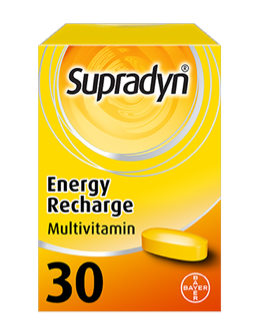FOR HEALTHCARE PROFESSIONALS
How Supradyn works: Impact on children and adolescents’ brain development
A child’s brain is constantly developing with rapid growth during the first two years and a continuous development until late adolescence.
During this period, the brain is particularly sensitive to micronutrient deficiencies. An optimal micronutrient status beneficially affects cognitive, behavioral, and academic performance. Thus, providing children and adolescents with correct amounts of essential vitamins and minerals is crucial. Among these micronutrients, DHA and choline have especially important roles. As research indicates, they may work together to support cognitive performance. Choline is an indispensable nutrient for brain development that is deeply involved in correct learning and memory processing. Likewise, DHA is also crucial for brain development. This predominant fatty acid is responsible for maintaining the structural and functional integrity of the central nervous system, optimal learning ability and mental development, as well as visual acuity. The probable synergism of choline and DHA in the brain may include the following mechanisms: membrane fluidity, cell membrane formation, neuronal communication, reduced oxidative stress and inflammation, and neuronal communication. Among other micronutrients, vitamin B6, B12, and B3 are important for the nervous system, cognitive function, and energy metabolism in the brain. They are also associated with the development of social perception and visuospatial abilities. Micronutrient deficiency can lead to several symptoms that affect learning, development and overall quality of life, including impaired cognitive performance and memory, poor reaction times, depression, fatigue, and confusion. Supradyn micronutrient supplements support children’s neural development and visual acuity. Our vitamins for kids help to establish a normal function and maintenance of their nervous system.
DHA and choline may work together to support cognitive performance26
Possible mechanisms of this synergism in the brain could include:26
Involved in the energy metabolism of the brain as well as in the synthesis of the neurotransmitters dopamine and noradrenalin.5
Potential consequences of insufficient micronutrients:
REFERENCES
- NestiMM, GoldbaumM. Infectious diseases and daycareand preschool education. J Pediatr(Rio J) 2007;83:299–312;
- Infections in child care centres. PaediatrChild Health 2000;5:495–6;
- Ferguson A, Penney R, Solo-Gabriele H. A Review of the Field on Children’s Exposure to Environmental Contaminants:A Risk Assessment Approach. Int J Environ Res Public Health 2017;14:E265;
- Simon AK, Hollander GA, McMichael A. Evolution of the immune system in humans from infancy to old age. ProcR SocB2015;282:20143085;
- MikolajczykRT, et al. Social contacts of school children and the transmission of respiratory-spread pathogens. EpidemiolInfect 2008;136:813–22;
- EamesKTD, et al. Measured dynamic social contact patterns explain the spread of H1N1v influenza. PLoSComputBiol2002;8:e1002425;
- MagginiSB, et al. Feeding the immune system: The role of micronutrients in restoring resistance to infections. CAB Review: Perspectives in Agriculture, Veterinary Science, Nutrition and Natural Resources 2008;3:98;
- Huskisson E, MagginiS, RufM. The influence of micronutrients on cognitive function and performance. J IntMed Res2007;35:1–19;
- Huskisson E, MagginiS, RufM. The role of vitamins and minerals in energy metabolism and well-being. J IntMed Res2007;35:277–89;
- DriskellJA. Vitamins and trace elements in sports nutrition. WolinskyI, DriskellJA (eds): Sports Nutrition: Vitamins and Trace Elements. 49–83. CRC Press, 1999;
- SoriceA, et al. Ascorbic acid: its role in immune system and chronic inflammation diseases. Mini Rev Med Chem2014;14:444–52;
- Kim Y, et al. Vitamin C is an essential factor on the anti-viral immune responses through the production ofinterferon-alpha/ beta at the initial stage of influenza A virus (H3N2) infection. Immune Net w2013;13:70–4;
- Barbosa E, et al. Supplementation of vitamin E, vitamin C, and zinc attenuates oxidative stress in burned children: a randomised, double-blind, placebo-controlled pilot study. J Burn Care Res2009;30:859–66;
- GaraiovaI, et al. Probiotics and vitamin C for the prevention of respiratory tract infections in children attending preschool: a randomised controlled pilot study. EurJ ClinNutr2015;69:373–9;
- PrietlB, et al. Vitamin D and immune function. Nut rients2013;5:2502–21;
- LoomanKIM, et al. The role of vitamin D on circulating memory T cells in children: The Generation R study. Pediatr Allergy Immunol2017;28:579–87;
- Bergman P, et al. Vitamin D and Respiratory Tract Infections: A Systematic Review and Meta-Analysis of Randomized Controlled Trials. PLoSOne 2013;8:e65835;
- Camargo CA Jr, et al. Randomized trial of vitamin D supplementation and risk of acute respiratory infection in Mongolia. Pediatrics2012;130:e561–7;
- GombartAF, BorregaardN, KoefflerHP. Human cathelicidinantimicrobial peptide (CAMP) gene is a direct target of the vitamin D receptor and is strongly up-regulated in myeloid cells by1,25-dihydroxyvitamin D3.FasebJ2005; 19:1067–77;
- PrietlB, et al. Vitamin D and immune function. Nut rients2013;5:2502–21;
- Wang TT, et al. Cutting edge: 1,25-dihydroxyvitamin D3 is a direct inducer of antimicrobial peptide gene expression. J Immunol2004;173:2909–12;
- Tomiyama K and Arakawa Y. [Zinc-and tin-induced apoptotic mechanisms in immune system and cranial nerve system. Nihon Rinsho2016;74:1111–9;
- Prasad AS. Discovery of human zinc deficiency: its impact on human health and disease. AdvNutr2013;4:176–90;
- Singh M and Das RR. Zinc for the common cold. Cochrane Database SystRev2013:CD001364;
- Kumar V and ChoudryVP. Iron Deficiency and Infection. Indian J Pediatr2010;77:789–93;
- Hassan TS, et al. Impact of iron deficiency anemiaon the function of the immune system in children. Medicine2016;95:47;
- JonkerFAM, et al. Anaemia, iron deficiency and susceptibility to infection in children in sub-Saharan Africa, guideline dilemmas. Br J Haemat ol2017;177:878–83;
- ZielinskaA and Nowak I. Abundance of active ingredients in sea-buckthorn oil. Lipids Health Dis 2017;16:95;
- Patel CA, et al. Remedial Prospective of HippophaerhamnoidesLinn. (Sea Buckthorn). ISRN Pharmacol2012:436857;
- LarmoP, et al. Effects of sea buckthorn berries on infections and inflammation: a double-blind, randomized, placebo controlled trial. EurJ ClinNutr2008;62:1123–30;
- SagguS and Kumar R. Modulatory effect of sea buckthorn leaf extract on oxidative stress parameters in rats during exposure to cold, hypoxia and restraint (C-H-R) stress and post stress recovery. J Pharm Pharmacol2007;59:1739–45;
- EnkhtaivanG, et al. Extreme effects of sea buckthorn extract on influenza viruses and human cancer cells and correlation between flavonolglycosides and biological activities of extracts. Saudi J BiolSci2017;24:1646–56;
- TorelliA, et al. Sea buckthorn bud extract displays activity against cell-cultured Influenza virus. J PrevMed Hyg2015;56:E51–6;
- UpadhyayNK, Kumar MS, and Gupta A. Antioxidant, cytoprotective and antibacterial effects of sea buckthorn (HippophaerhamnoidesL.) leaves. Food ChemToxicol2010;48:3443–8.
- Micronutrient requirements of children ages 4 to 13 years. Oregon State University. Available from: https://lpi.oregonstate.edu/mic/life-stages/children. Accessed August 2018;
- Micronutrient requirements of adolescents ages 14 to 18 years. Oregon StateUniversity. Available from: https://lpi.oregonstate.edu/mic/life-stages/adolescents. Accessed August 2018;
- KarpinskiM, et al. Roles of vitamins D and K, nutrition, and lifestyle in low-energy bone fractures in children and young adults. J Am CollNut r2017;36:399–412;
- IOM (Institute of Medicine). 2011. Dietary Reference Intakes for Calcium and Vitamin D.Washington, DC: The National Academies Press;
- SolimanAT, et al. Vitamin D deficiency in adolescents. Indian J EndocrinolMetab2014;18(Suppl1):S9–S16;
- Kruger HS. The necessity for a balanced diet in children: physical, mental and intellectual development. Available from: http://www.fao.org/fileadmin/templates/est/COMM_MARKETS_MONITORING/Dairy/Documents/02__Kruger_pres.pdf. Accessed August 2018;
- EFSA, Scientific Opinion on the substantiation of a health claim related to vitamin D and contribution to normal bone and tooth development pursuant to Article 14 of Regulation (EC) No 1924/2006. EFSA Journal2014;12:3579;
- Vitamin D, in dietary reference intakes for calcium and vitamin D. A report of the panel on micronutrients, standing committee on the scientific evaluation of dietary reference intakes; food and nutrition board.Institute of Medicine2010, National Academy Press: Washington, D.C. 75–456;
- DeLuca HF. The vitamin D story: a collaborative effort of basic science and clinical medicine. FasebJ 1988;2:224–36;
- Bonjour JP, et al. Peak bone mass. Ost eoporosInt1994;4(Suppl1):7–13;
- KapilU. Health Consequences of Iodine Deficiency.Sult an QaboosUniversity Medical Journal2007;7:267–72;
- Zimmermann MB. The role of iodine in human growth and development. SeminCell Dev Biol2011;22:645–52;






